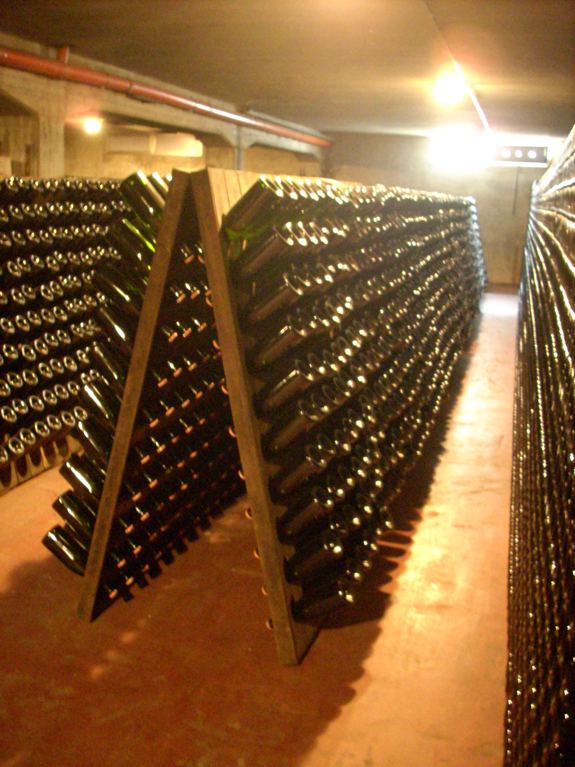
The Lini family has been making Lambrusco in Correggio, in Emilia-Romagna since 1910. Now onto its fourth generation, the winery has achieved critical success for its Lambrusco including being nominated one of Opera's 100 Greatest Wine Producers by Wine Spectator in 2015, and being included in this year's Wine Spectator "Top 100 Values Under Twenty Dollars."
Lambrusco is a complicated wine. Over 60 varieties of Lambrusco grapes have been identified (the Lini wines are based around Lambrusco Salamino). There are three methods for making Lambrusco wines which include the traditional Champagne method and a method called "method ancestral" or "pet nat" where yeasts are left in the bottle to create fizz. Lini mostly uses the traditional method for Lambrusco, called the "Charmat process," where a second fermentation is conducted in a pressurized tank.
Lini Lambrusco is a great food wine or good for sipping on a hot summer day. It is medium bodied, has the classic Lambrusco fizziness, light tannin and notes of plum, raspberry and cherry. These are wines of complexity but also of tremendous value.
Grape Collective talks with fourth generation Alicia Lini about what makes classic Lambrusco and the challenges of the cheap reputation Lambrusco suffered in the 1970s and 1980s.
 Christopher Barnes: So talk a little bit about the history of the estate.
Christopher Barnes: So talk a little bit about the history of the estate.
Alicia Lini: Our Cantina was born in 1910 when my great-grandfather started to produce wine. Then there is the generation of my grandfather, my dad, my uncle, and my aunt; and the new generation, represented by me, my cousin and my brother.
How has the winemaking changed over time?
Four generations is four different worlds, so, we were and we are producers of sparkling wine and balsamic vinegar, and we have always used not just the Charmat method for Lambrusco, but also the Champenoise method. We are not allowed to say this anymore, we have to say the "classic method." And we used this method for the first time in the early '50s.
And are you still using both methods?
Both methods, and of course the Charmat method is well known, and the classic method is a little bit less produced because it's a completely manual method still for us. We just put away every single bottle we make the degorgement manually so it's a very big job.
Lambrusco is quite a complicated wine, isn't it?
Very.
I mean, there are different soils, different grapes, there are different methods, I mean, how do you explain Lambrusco to somebody who knows nothing about it?
Lambrusco is a very simple wine that comes from a very complicated story. Because in the past, it's been destroyed, the name and the fame, because it's been produced in a very quick way. You can produce, obtain a sparkling Lambrusco in three days, in a week, but our entry level products will stay in the big tank for at least three months. So between a week and three months, there is a world of difference. I mean, again, if you obtain a Lambrusco in a very quick way, you obtain something different from a red Coke. And in months, you will obtain a pop wine, a popular wine, simple wine, that doesn't pretend to be, but it is something very, very, very delicious and elegant in a way, even if it is a rustic wine.
 Are there different methods of making Lambrusco?
Are there different methods of making Lambrusco?
Charmat is probably the most used method. You keep the wine, as I said to you before, for three to six months, for early 1910, and then you bottle the wine. The longer the method is, the more the wine is well done, and the sparkling is incorporated into the product, so the pleasure that you have in drinking a glass of Lambrusco is bigger.
And Lambrusco has had a bit of a checkered history, right?
Years and years ago, probably Americans were not used to drinking wine as much as today. But at the same time the quality of Lambrusco that Italy exported wasn't that good, so, we didn't build a market. We have been the first at the start to export to the United States, and we stepped back because the quality was too bad and we could not compromise ourselves in doing that level of product. Then, we have been the first to come back to the States, and believing that there was a space for high-quality Lambrusco, and proposing to the consumer a product, not just Charmat method, but also Champenoise, and people recognized this and it has been very successful.
So there's like this new wave of Lambrusco where it's more artisanal in a way, but it seems like it has a lot more character than the Lambruscos that people kind of associate with the old style of Lambrusco.
Yes, like those who have defended their own quality today are succeeding, and also, we have changed our way to drink and to eat. We have to admit that we eat lively and we drink lively. So, just if you think back to 10 years ago, what was trendy was to drink very woody, still important, very alcoholic wine. Today, sparkling wine. It's our magical moment.
 How would you describe the flavor of a modern Lambrusco?
How would you describe the flavor of a modern Lambrusco?
Every Lambrusco is dry. If you obtain a Lambrusco in a very quick way, the fermentation is so quick that it doesn't stay in the bottle, so you have to add residual sugar in order to keep the wine inside the bottle, so it's a technical thing. Lambrusco is a very food-friendly wine. We come from Emilia-Romagna, and Emilia is considered the "stomach" of Italy. It's part of our menu, lasagna, tortellini, tortelli; all the rich food comes from Emilia-Romagna, and we need this light wine in order to compensate and balance out this richness. So Lambrusco is very food friendly, and it cannot be food friendly if it was sweet. Do you understand what I mean?
How would you describe Lambrusco in terms of its flavor profile to somebody who has never tasted it before?
Lambrusco is a very big family, it is difficult to describe one Lambrusco, because it's like, it's a big family with so many sons and daughters, and the sons and daughters are the grape varieties that you can find in a Lambrusco; and the Lambrusco Salamino, the Lambrusco Marani, Lambrusco Grasparossa, Lambrusco Sorbara, and every different variety gives something different to the wine. So our cherry is not that small and our variety is different from one to another, so it depends which you decide to work with.
And what grapes do you work with?
Mostly Salamino, Lambrusco Salamino, we use a percentage of Sorbara and the rosé we produce, and we also use the classic method and the Charmat method. In the classic method we use Pinot Noir. We are also a traditional balsamic producer.
And what is your philosophy of winemaking in viticulture?
It is true that a good wine is born in a good vineyard, at the same time when you approach a sparkling environment, sparkling wine is mostly made in the time that you decide to work with, through a Charmat, long Charmat, or aged classic method.
 Now talk a little bit about some of the wines that you make right now.
Now talk a little bit about some of the wines that you make right now.
We have three lines, one is a Lambrusco line, which is really rustic, and obtained in three months of fermentation. There is a white, a rosé and a red, and this year The Wine Spectator inserted our Lambrusco in the "Top 100 Values Under Twenty Dollars" quality prize, so it was a really good result.
Congratulations.
Thank you. And then we have an In Correggio line, still Charmat method, obtained in six months of fermentation, and we have a Lambrusco rosé, Pinot Spumante, Moscato Spumante, and then we have a line of classic method. Classic method, milleseme and paduse is the difference between a Pinot Noir and Lambrusco.
So your classic method Lambrusco, how would you describe it?
Years ago, Wine Spectator invited us to the event called Opera Wine that they organized before VinItaly, and we had been invited as part of the best 100 cantina for them, from Italy, and we were in it thanks to our Millesimato 2004. So this is the reason why this bottle is here today. It's a very romantic bottle, but if you believe that, you are the type to believe in quantity, not quality, and you still make this manually, we sign every single bottle, and we spend more than 12 years to leave the wine there, while outside everybody just focuses on a very quick Lambrusco, this is really romantic.
For more on Lambrusco:
Check out our interview with Fattoria Moretto
Eric Asimov in the New York Times on Lambrusco
Find Lini Lambrusco on Grape Collective or find a retailer via Winesearcher.














